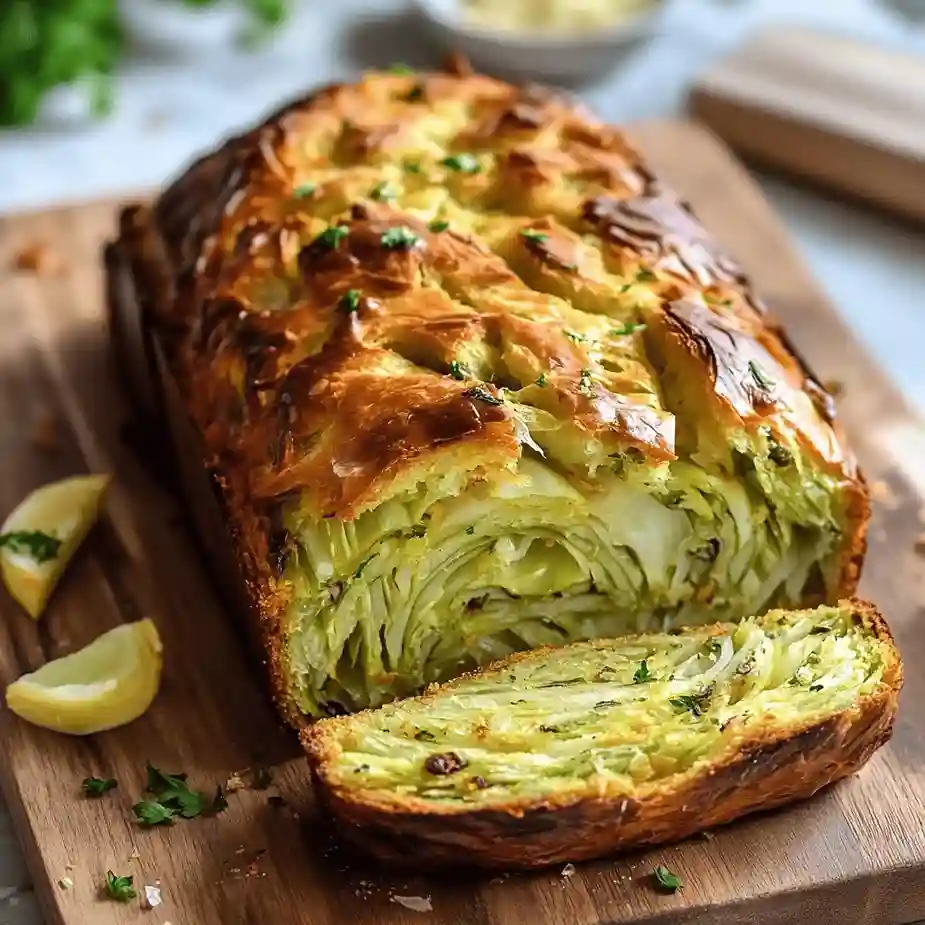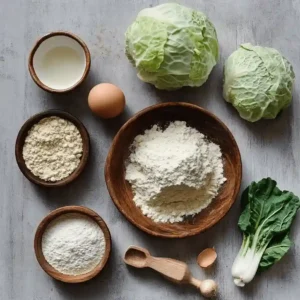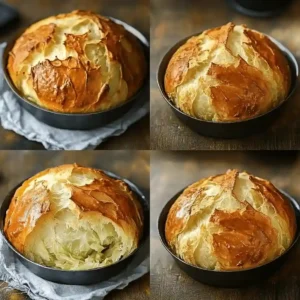Cabbage Bread Recipe is a creative twist on traditional bread, offering a nutrient-packed, flavorful, and moist alternative that’s perfect for breakfast, lunch, or even a midday snack! With the right combination of ingredients and a little know-how, you can bake your very own loaf of cabbage bread right at home.
Why Make Cabbage Bread?
Cabbage bread is more than just a tasty treat there are plenty of reasons to give this recipe a whirl:
- Healthy Alternative: Cabbage is low in calories and packed with vitamins C and K, making this bread a healthier option than traditional loaves.
- Unique Flavor and Texture: The cabbage lends a subtle sweetness, moist texture, and soft crumb, perfect for sandwiches or serving alongside a meal.
- Easy to Make: With simple ingredients and steps, this recipe is accessible to both baking novices and seasoned pros.
Now, let’s get started!
Ingredients for Cabbage Bread
Before you begin, gather all the necessary ingredients. This will make your bread-making process smoother and ensure you have everything you need on hand.
Base Ingredients
- 2 cups of finely shredded cabbage (green or red)
- 3 ½ cups of all-purpose flour (you can substitute with whole wheat flour for a healthier option)
- 1 packet (2 ¼ teaspoons)
- 1 teaspoon of sugar
- 1 teaspoon of salt
- 1 cup of warm water (not too hot around 110°F/45°C is ideal for activating yeast)
- 3 tablespoons of olive oil or melted butter
Optional Add-ins (for extra flavor)
- 1 teaspoon of garlic powder or onion powder
- A pinch of black pepper or chili flakes for a slight kick
- 2 tablespoons of grated Parmesan cheese
These add-ins are optional, but they can take your cabbage bread to the next level!
Instructions for Making Cabbage Bread
Now that you’ve gathered your ingredients, it’s time to bake! Here’s a step-by-step guide to ensure success.
Step 1: Prep the Cabbage
- Finely shred your cabbage (thin strands work best). You can use a food processor or a box grater for this step.
- Steam or blanch the shredded cabbage for 3-4 minutes. Once softened, drain any excess water and pat the cabbage dry with a clean kitchen towel—removing as much moisture as possible is critical for the final consistency of your bread.
Step 2: Activate the Yeast
- Stir gently and allow the mixture to sit for 5-10 minutes until it becomes foamy. This step ensures your yeast is active and ready to help your bread rise.
Step 3: Mix the Dough
- In a large mixing bowl, combine the flour, salt, and any optional seasonings or herbs you’re using.
- Create a small well in the center of the dry ingredients and add the yeast mixture, olive oil (or melted butter), and shredded cabbage.
- Mix the ingredients together with a wooden spoon or your hands until a dough starts to form. If your dough feels too sticky, add a tablespoon of flour at a time until it holds together.
Step 4: Knead the Dough
- Transfer the dough to a clean, floured surface. This step develops the gluten, giving your bread a nice structure.
- If you’re using a stand mixer, you can knead the dough on medium speed for 5-6 minutes with a dough hook attachment.
Step 5: First Rise
- Allow the dough to rise in a warm, draft-free area for 1 to 1.5 hours, or until it doubles in size.
Step 6: Shape the Dough
- Shape the dough into a round or oval loaf, or divide it into smaller rolls if you prefer individual servings.
Step 7: Second Rise
- Cover the shaped dough and allow it to rise again for 30-40 minutes.
Step 8: Bake
- Preheat your oven to 375°F (190°C).
- Brush the top of the dough lightly with olive oil or melted butter for a golden crust. You can also sprinkle sesame or poppy seeds on top for extra texture.
Step 9: Serve and Enjoy
Slice your cabbage bread and serve it warm with butter, as a side to soup, or as the base for your favorite sandwich.
Tips for Perfect Cabbage Bread Every Time
- Don’t Skip the Second Rise: This ensures that your bread is light and airy instead of dense.
- Control Moisture: Overly watery cabbage will affect the dough’s consistency. Be sure to dry it thoroughly after steaming.
- Experiment with Flavors: Don’t be afraid to play around with herbs and spices to make the bread your own.
- Store Properly: Wrap your bread in plastic or store it in an airtight container to keep it fresh for up to 3 days. It also freezes well!
Why You Should Try Cabbage Bread Today
Cabbage bread isn’t just a unique recipe—it’s a delicious and practical addition to your baking repertoire. Whether you’re looking to add something new to your dinner table or want to impress guests with your culinary skills, this bread fits the bill. Plus, it’s a wonderful way to sneak some extra vegetables into your day!
The Basics of Mixing Dough for Cabbage Bread
Making the perfect dough for cabbage bread starts with blending dry and wet ingredients well. A smooth, elastic dough is key for a delicious homemade cabbage bread.
Combining Dry and Wet Ingredients
Start by gathering dry ingredients like flour, yeast, and salt. Then, mix wet ingredients—water, oil, and sugar—to help yeast work. Slowly add wet to dry, stirring constantly to avoid lumps.
Kneading Techniques for Perfect Dough
When the dough comes together, knead it on a floured surface. Use your heels to push the dough away, then fold it back. Turn it slightly each fold. Knead for 8 to 10 minutes until it’s smooth and elastic.
This step ensures the dough’s gluten is developed. It makes the bread light and airy, just like great cabbage bread. Remember, the fun of bread making is in the journey, not just the end result.
Letting the Dough Rise: A Essential Step
When making your homemade cabbage dough bread, it’s crucial to let the dough rise. This step is key for a light, airy texture and deep flavors. It makes your bread special. Let’s explore how to create the perfect rise for your dough.
Ideal Conditions for Dough Rising
For your dough to rise well, you need the right environment. It should be warm, draft-free, and between 75°F and 85°F (24°C to 29°C). Humidity matters too; too little, and the dough might not rise right. Use a damp cloth to keep the dough moist.
Remember, the rise time can vary. So, watch your dough closely and adjust as needed for the best results.
Shaping and Filling Your Bread with Cabbage
When your dough has risen and doubled, it’s time to make delicious cabbage bread. Shaping and filling your bread is both an art and a science. This is where your creativity really shines through. Let’s explore how to make both cabbage roll bread and other tasty cabbage bread types.
Creating the Perfect Shape for Cabbage Bread
Start by flouring your work surface and placing your risen dough on it. If you want a loaf, shape the dough into a rectangular form. For cabbage roll bread, divide your dough into smaller parts, roll each into a ball, and then flatten them into oval shapes. Make sure the dough is even but not too stretched, as it could tear when filled.
Incorporating the Cabbage Filling
Now, your delicious cabbage bread recipe needs the signature cabbage filling. Mix your pre-cooked cabbage with spices, herbs, and other ingredients like onions or minced meat for extra flavor. Place a spoonful of this mixture in the center of your dough shape. For rolls, bring the edges together and seal them, ensuring the filling is snugly enclosed. With a loaf, roll the dough over the filling, tucking in the ends to keep the cabbage inside during baking.
These shaping and filling techniques not only influence the final taste but also affect your bread’s texture and appearance. Experimenting with different variations can lead to a range of delicious outcomes. Whether you choose traditional roll shapes or innovative loaf designs, the result is always a warm, inviting cabbage bread that’s perfect for any meal.
Optimal Baking Techniques for Delicious Cabbage Bread
Learning to bake the perfect cabbage bread can seem hard. But with the right techniques, you’ll soon enjoy tasty cabbage baked goods. This guide will help you get that golden crust and soft inside, key to great cabbage bread.
Baking time is key. Cabbage bread usually bakes for 20 to 30 minutes. Check it after 20 minutes. It should sound hollow and have a golden crust.
| Baking Issue | Potential Cause | Quick Fix |
|---|---|---|
| Under-baked center | Oven too hot causing rapid outside browning | Lower the oven temperature and increase bake time |
| Uneven browning | Incorrect oven rack position | Position in the middle of the oven and rotate mid-bake |
| Too dense | Insufficient rising time | Allow more time for the dough to rise before baking |
The perfect cabbage bread needs the right ingredients and technique. Follow these tips to master your recipe. Happy baking!
Optimal Baking Techniques for Delicious Cabbage Bread
Making delicious cabbage bread is all about mixing tradition with precision. Recipes with yeast, like cabbage bread with yeast, need exact baking conditions. We’ll look at temperature and moisture, key for a tasty and good-looking loaf.
The right oven temperature is crucial. Baking cabbage bread should be between 375°F and 400°F. This ensures a golden crust and cooks the cabbage and dough well. The mix of cabbage sizzle and yeasty smell makes it a treat.
Professional bakers use steam for a crispier crust. You can do the same at home. Place a shallow metal tray with water at the oven’s bottom during preheating. As it heats up, the water turns to steam, making your crust crackly and artisan-like.
Using these techniques makes your cabbage bread even better. It becomes a masterpiece, with each slice showing off a fluffy inside and a crispy crust. Every bite is as tempting as the last.
Cooling and Serving Your Cabbage Bread
After baking your cabbage bread, don’t rush to cut it. Cooling it right is key for the best taste and texture. This is especially true for beginners, as it prevents a gummy texture. Let it cool on a wire rack for at least an hour.
This step lets the steam out and the bread to firm up. It makes slicing easier.
Thinking about serving your loaf, cabbage bread is versatile. It can add flavor to any meal. You can serve it fresh with butter or as a side dish.
- For a simple snack: Slice the cabbage bread and toast it lightly. Serve with a dip such as cream cheese or a savory chutney.
- As part of a meal: Pair the bread with a hearty soup or stew. The bread’s robust texture makes it ideal for dipping and soaking up flavors.
- Creative sandwiches: Use thick slices of cabbage bread as the base for sandwiches. The bread’s flavor complements both cold cuts and vegetarian options like grilled veggies.
You now know how to bake, cool, and serve an amazing cabbage bread loaf. It’s not just about taste. It’s about creating a memorable experience for everyone.
Variations of the Classic Cabbage Bread Recipe
Exploring different cabbage bread variations is exciting. You can make a gluten-free version, a cheesy vegetarian option, or a vegan recipe. This way, you can customize the bread to fit your dietary needs and taste preferences.
Making Gluten-Free Cabbage Bread
For those with gluten sensitivities, a gluten-free cabbage bread is a great option. Use a mix of gluten-free flours like rice, tapioca, and chickpea. This blend gives a good texture and taste, matching the cabbage’s natural flavor. It’s a healthy twist for your baking.
Trying Different Cabbage and Cheese Combinations
Experimenting with cabbage and cheese is rewarding. Try cabbage and cheddar bread for a rich taste. You can also use Gruyère or mozzarella for a milder flavor. These changes will broaden your cooking skills and please your palate.
Storing and Reheating Your Cabbage Bread
After enjoying the unique flavor of healthy cabbage bread or the delightful twist of cabbage garlic bread, knowing how to store cabbage bread properly is essential to maintaining its freshness and taste. Here are some practical tips to help you keep your cabbage bread as delicious as the day it was baked.
Best Methods for Reheating
To enjoy your cabbage bread as if it were fresh out of the oven, proper reheating is crucial. If you’ve stored your bread in the refrigerator, you can revive its crispy crust by warming it in the oven. Preheat your oven to 350°F (175°C) and place the bread directly on the rack for about 5-10 minutes. For those who have frozen their bread, allow it to thaw at room temperature before reheating it in the oven. This process helps in preserving the bread’s moisture and texture, giving it that freshly baked taste and feel.
Conclusion
If you’ve followed our guide, you now know how to make the best cabbage bread recipe at home. Choosing the right ingredients and baking it with care makes a big difference. This delicious cabbage loaf recipe is special because you made it yourself.
Success in baking comes from being patient and precise. Whether you’re new to baking or have lots of experience, you can always make this recipe your own. Don’t be afraid to try new things and make it your own.
We want you to share your baking stories online. Your experiences and photos might inspire others to try this recipe. Homemade bread brings warmth and comfort to your home.
Thank you for joining us on this cabbage bread journey. We hope you enjoy baking and eating this bread as much as we do. Happy baking!
What is the healthiest way to eat cabbage?
Looking into the best ways to eat cabbage can lead to many healthy choices. A healthy cabbage bread recipe is a great way to get your daily dose of nutrients. Cabbage is packed with vitamins, minerals, and fiber, all key for good health.
Eating raw cabbage is one of the best ways to get its benefits. It keeps all its antioxidants and fiber, which can lower bad cholesterol. But, if you want to try something new, a cabbage and bread recipe is a tasty option. It lets you enjoy cabbage in a fun and flexible way.
If you’re into plant-based eating, a vegetarian cabbage bread is perfect. Using whole grain flours and shredded cabbage, you get a loaf that’s both tasty and nutritious. This way of making cabbage bread is great for a healthy meal that tastes like homemade.
How does Jamie Oliver cook cabbage?
Exploring Jamie Oliver’s cabbage method can open up new vistas in your kitchen. If you’re keen on enhancing your culinary cabbage bread, you’ll find his approach useful. Jamie Oliver makes cooking cabbage simple yet elegant, even with the humblest ingredients.
One of Jamie Oliver’s favorite methods is sautéing cabbage quickly with high heat. This keeps it crisp and enhances its natural flavors. You can adapt this technique for your cabbage bread recipes. Try adding sautéed cabbage, seasoned with garlic, salt, and olive oil, to your dough!
Moreover, Jamie Oliver stresses the importance of seasoning cabbage right. A squeeze of lemon juice often accompanies his cabbage dishes. This brings out vibrant flavors that make your cabbage bread truly stand out.
How to store cabbage bread?
After mastering cabbage bread baking, the next step is storing it right. This keeps your bread fresh and tasty. Proper storage is key to enjoying your hard work for days or weeks.
For short-term storage, place your bread in a cool, dry spot. Don’t use plastic bags, as they trap moisture. Instead, use a bread box or paper bag for better air flow. This helps keep the crust crunchy.
Also, slice your bread only when you need it. This prevents the cut sides from drying out. These tips will keep your bread delicious for a few days.
For longer storage, freezing is a great option. Let the bread cool completely before freezing. Wrap it in foil or a plastic bag to prevent freezer burn.
FAQ
What makes cabbage bread unique?
Cabbage bread is special because it combines homemade bread comfort with cabbage’s savory taste. It’s flexible, using various ingredients, and has a unique texture. This makes it different from regular bread.
Can I make cabbage bread if I’m new to baking?
Yes, you can! The recipe is easy to follow, perfect for beginners. It also teaches basic baking skills that you can use later.
What kind of flour is best for cabbage bread?
Bread flour is best because it has a lot of protein. This helps the bread stay strong. For gluten-free, a mix with xanthan gum works well. Your choice depends on your diet and taste.


